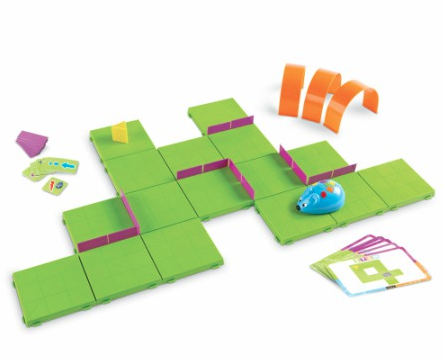
Code and Go Robot Mouse

Overview
The students will learn coding skills with Colby, the programmable robot mouse. The students build a maze with the 16 maze grids, a 20" x 20" maze board, 22 maze wall and three tunnels that are provided in the kit. The students will program the sequence of steps and Colby will race to find the cheese. There are also 30 double-sided coding cards, 10 double-sided activity cards, a cheese wedge, and an activity guide to provide the perfect hands-on introduction to coding concepts. You can even add Jack the programmable robot mouse to race Colby!
This is a great STEAM activity for the students. This activity will take several class periods. Students will need time to create the maze first.
Learning Objectives
Students will:
- Be able to learn basic coding skills.
- Be able to understand the basic components of computational thinking.
Vocabulary
Vocabulary Words:
- Coding: Coding is writing instructions for a computer to perform and create computer software, apps and websites.
- Computational Thinker: A computational thinker develops and employs the thought processes involved in formulating a problem and expressing its solution(s) in such a way that a computer-human or machine—can effectively carry out.
Pre-planning
To prepare for this lesson:
- Purchase the Code & Go Robot Mouse Set
- Code & Go Robot Mouse Activity set from Learning Resources - approximately $35
- Code & Go Robot set from Walmart, and Amazon
- Purchase the second mouse Jack from any of the companies above.
- Purchase triple A batteries for the mice.
- Read this article with tips and hints for the activity set.
- Watch this short video on how to program your robot mouse.
-
Assemble the green tiles and design a maze with a starting
and ending location (cheese); program/code the mouse to navigate the maze -
The teacher will need to decide whether or not to build the maze themselves or have the students do it. If the students build it, this activity will take several class periods.
-
Each kit will work for two students if paired up. Determine how many kits will be needed for your classroom. If used for a learning center, two or three would suffice.
Accommodations
See the Accommodations Page and Charts on the 21things4students website in the Teacher Resources.
Steps
Directions for this activity:
-
The teacher will introduce basic coding to the students.
-
The teacher will demonstrate how the robot mouse can be programmed by using the coding activity cards.
-
Then the students will enter the code sequence into Colby (blue) or Jack (purple).
-
The Green button starts the program, the yellow button clears the program and the red button is for action (lightning bolt on the activity card).
-
Pressing a turn arrow only turns the mouse - no forward movement.
-
Never force or push the mouse or it will strip the gears (replacement mice are around $23 each).
-
The students will set up the maze for Colby the mouse to go through.
-
The students can either follow the activity cards or design their own.
-
The students can use the maze walls to create traps and dead-ends and bridges to guide Colby in a certain direction.
-
Watch the mouse when it reaches the cheese!
Additional Activity:
- Students can create their own maze. The mice can go on multiple surfaces.
Assessment Options
Different options for assessing the students:
- Observations
- Check for understanding
- Create a simple rubric for how well the students program the mouse, maze building and collaborating with others.
MITECS COmpetencies & ISTE STANDARDS
MITECS: Michigan adopted the "ISTE Standards for Students" called MITECS (Michigan Integrated Technology Competencies for Students) in 2018.
Computational Thinker
5a. Students formulate problem definitions suited for technology-assisted methods such as data analysis, abstract models and algorithmic thinking in exploring and finding solutions.
5c. Students break problems into component parts, extract key information, and develop descriptive models to understand complex systems or facilitate problem-solving.
5d. Students understand how automation works and use algorithmic thinking to develop a sequence of steps to create and test automated solutions.
Devices and Resources
Device: PC, Chromebook, Mac, iPad
Browser: Chrome, Safari, Firefox, Edge, ALL
Websites:
Amazon Code & Go Robot set
Code & Go Robot Activity Set from Learning Resources
CONTENT AREA RESOURCES
ELA
The students can write a short story about the adventures that the mice are having.
Integrated Arts
The students will design their own maze for the mice to go through.
Math
-
The students are learning basic coding.
-
Program the mouse to trace various geometric shapes
Science
The students are learning the basics of engineering/programming the mouse to go through the maze.
CREDITS
This task card was created by Andy Mann, REMC Director, Muskegon Area ISD and Melissa White, 21Things Project Manager. Updated October 2023.


